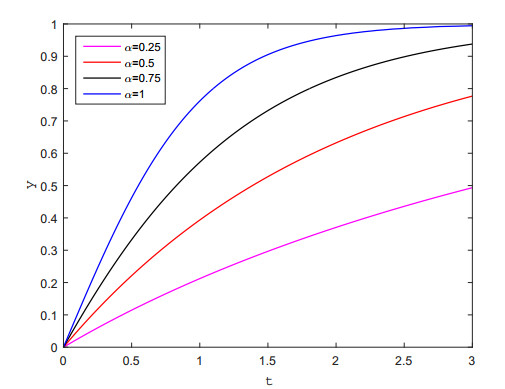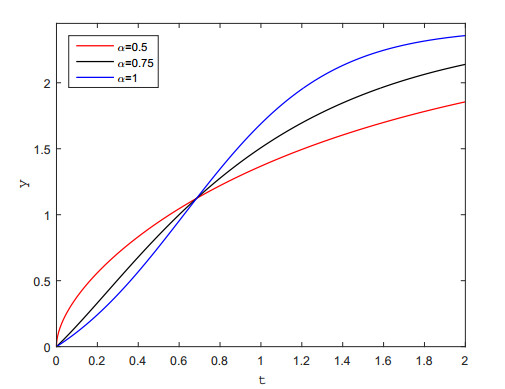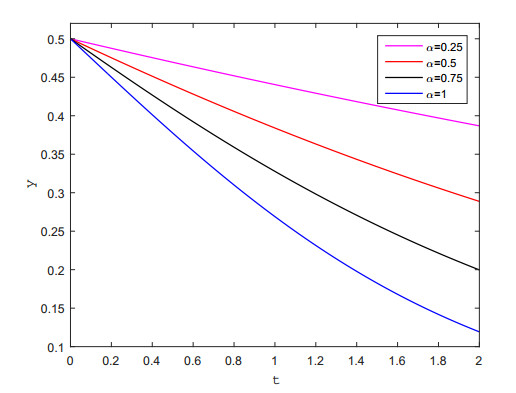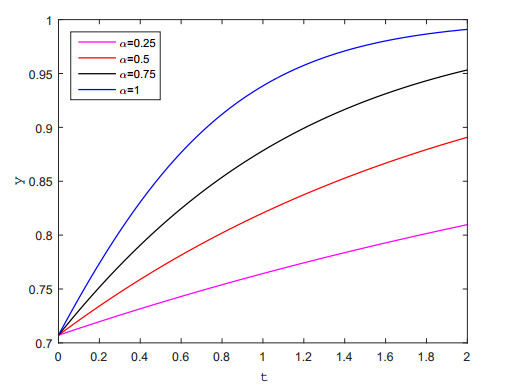1.
Introduction
Fractional calculus is a generalization of classical integer calculus. Just like the powerful application of classical calculus, the effectiveness of fractional calculus does not depend on its mathematical properties, but on its ability to describe related phenomena. Because it has genetic characteristics and can well describe memory, the modeling of many phenomena mostly depends on fractional calculus. It has become a useful tool to describe complex dynamics in engineering, industrial scientific application, biomedical science and technological development (see [1,2] and the references therein). As we all know, there is no universal definition of fractional calculus, and fractional differential operators have many forms, such as Riemann-Liouville, Caputo, Riesz, Riesz-Caputo, Weyl, Hadamard, Chen, etc. Many researchers are still committed to introducing new fractional derivative operators and applying these new operators to some practical problems [3,4]. Of course, each constructed fractional operator has its specific characteristics and properties, which are suitable and easy to represent specific problems. The list of reasonable properties of fractional operators has been given in [5]. In addition, some researchers have proposed that if the differential operator does not satisfy the exponential law, it cannot be called derivative or fractional derivative. Labora and Nieto and Rodríguez-López proved that there is no a fractional derivative that verifies index law [6].
Fractional calculus has become an active research field for some reasons or weaknesses: the case of the local singular kernel and the case of the nonlocal nonsingular kernel. The fractional derivatives such as Riemann-Liouville type and Caputo type, which are widely used in many models, have singular kernels in their definitions. In recent years, the development of new nonlocal fractional derivatives with nonsingular kernels have attracted great interest [7,8]. The idea is to have more types of nonlocal fractional derivatives, and which fractional order model is appropriate will be measured in the simulation. In order to avoid the singular kernel problem, Caputo and Fabrizio proposed a new fractional derivative, which uses the exponential function as the kernel function [9]. The emergence of the new definition of fractional derivative with exponential kernel is an answer to the requirement that many classical constitutive equations can not fully simulate the dissipation process of energy (heat), mass (diffusion) and stress behavior of many new materials in modern technology. In many investigations, it has been found that the new operator can effectively describe various processes in the best way (for example, see [10,11]). Caputo-Fabrizio derivative has also been used to represent many problems in various fields, such as, biology, infectious diseases and even to study the evolution of COVID-19 epidemic, which can be found in [12,13,14,15,16,17,18]. The concept of Caputo-Fabrizio fractional derivative and its applications have been modified in literatures [19,20,21]. In [21], the logistic differential equation of fractional order and nonsingular kernel was solved and the analytical solution was obtained. For more information on the meaning of nonsingular kernel, please refer to [22,23]. For the solutions of fractional differential equations with singular or nonsingular kernels, see [24,25,26,27,28,29,30,31,32,33].
Inspired by [21], this paper studies the solutions of three kinds of classical differential equations with the Caputo-Fabrizio fractional derivative: the Riccati equation, the anti logistic equation and the simple nonlinear model for the ENSO phenomenon. Some of the examples considered are classical ones in order to obtain the comparison of results under different fractional order operators. The purpose is to give some new results of classical differential equations. The structure of this paper is as follows: in Section 2, the related properties of Caputo-Fabrizio fractional order operators are reviewed. In Section 3, the implicit solutions are studied for the specific equations, and the image of the implicit solutions are drawn. Section 4 summarizes the work of this paper.
2.
Basic properties of Caputo-Fabrizio fractional derivative
Definition 2.1. Fractional derivative in Caputo sense defined as
in which 0<α<1 is the fractional order, Γ(s)=∫+∞0e−tts−1dt is the Gamma function.
Definition 2.2. The answer of Caputo and Fabrizio to the new call in modeling of relaxation process in dissipative phenomena was the following constitutive definition [9,18,19,26]
in which f is a real smooth function, M(α) is a normalization function such that M(0)=M(1)=1.
This is the definition of the Caputo-type because there is a derivative under the integral sign. It is analogous to the Caputo fractional derivative in the fact that one replaces the constant 1Γ(1−α) by M(α)1−α and the singular kernel
is replaced by the exponential function kernel
but now the kernel K(t,τ) is no singularity for t=τ.
By the Definition (2.2), it follows directly that if f(t)=C (C is a constant), then CFDαtC=0 as in the Caputo sense (2.1). Moreover, it follows that
and
Then, the Caputo-Fabrizio fractional integral (anti-derivative) of order α was proposed as
in which g∈H1, 0<α≤1.
Losada and Nieto improved the original definition of the fractional derivative of Caputo-Fabrizio and suggested a new definition [19], namely
here M(α) is accepted to equal 1. The Caputo-Fabrizio derivatives (2.6) of some elementary functions have been derived in [23].
The corresponding fractional integral of a function g is
In fact, the integral of the function given by Caputo and Fabrizio is the average of the function itself and its Riemann-Liouville integral.
Thus,
where c an arbitrary constant. However, as remarked in [18,21]
3.
Solutions of some typical nonlinear differential equations
In this section, some nonlinear ordinary differential equations with Caputo-Fabrizio fractional derivative will be solved, and the calculated results of different fractional orders are compared.
Example 1. Consider the α-th order fractional Riccati equation,
subject to the initial condition y(0)=0.
In the case of α=1, the fractional equation is simplified to the classical integer-order Riccati differential equation. The importance of these equations usually appears in the optimal control problem. The feedback gain of linear quadratic optimal control depends on the solution of Riccati differential equation, which must be found in the whole time range of the control process [34,35].
When α=1, the exact solution is given in [35]
and we can observe that, as t→∞, y(t)→1.
Let y(t) is a solution of (3.1), integrating of (3.1) can be obtained
By (2.8), the following expression can be obtained,
Sort out (3.4) and we can get
Taking the first derivative,
or
In the case of α=1, (3.7) is restored to the integer-order ordinary differential equation, the constants −1 and 1 are solutions. For 0<α<1, when y(t)≠−1,1, we rewrite (3.7) as following
Integrating of (3.8) can be obtained
Therefore
By the initial condition y(0)=0, we can get
then c=0.
Therefore, we obtain the implicit solution of (3.1) is
It can be verified that the implicit solution (3.12) is consistent with (3.2) when α=1.
The implicit solutions (3.12) for different fractional order α is plotted in Figure 1. As can be seen from Figure 1, the higher the α is, the more the corresponding image is above.
Table 1 shows a comparison of the results between the Riccati equation under Caputo fractional derivative solved by the modified homotopy perturbation method in [35] and the values of (3.12) under Caputo-Fabrizio fractional derivative. From the comparison in Table 1, it is clear that when α = 0.5,0.75 the values of (3.12) is smaller than the approximate solutions in [35]. It can also be found that the value of the solution under the Caputo-Fabrizio fractional derivative changes more gently from α=0.75 to α=1. It can also be seen from Table 1 that when α=1, the degree of solution coincidence in the two cases is high, indicating that the results of the two forms of fractional operators are consistent when the order tends to integer order.
Example 2. Consider the following fractional Riccati equation,
subject to the initial condition y(0)=0.
When α=1, the exact solution is
and we can get that, as t→∞, y(t)→1+√2.
Let y(t) is a solution of (3.13), similar to the method of Example 1, it can be obtained that
or
When α=1, (3.16) is restored to the classical ordinary differential equation, the constants 1+√2 and 1−√2 are solutions. For 0<α<1, when y(t)≠1±√2, we rewrite (3.16) as following
Integrating of (3.17) can be obtained
Therefore
By the initial condition y(0)=0, we can get
Therefore, we obtain the implicit solution of (3.13) is
The implicit solutions (3.21) for different fractional order α is plotted in Figure 2. Table 2 shows the comparison between the approximate solutions under Caputo fractional derivative solved in [35] and the values of (3.21) under Caputo-Fabrizio fractional derivative. From the results in Table 2, it is clear that the values of (3.21) is smaller than the approximate solutions in [35] in most cases and the growth of value is also relatively flat. It can also be seen from Table 2 that when α=1, the degree of solution coincidence in the two cases is high.
Example 3. Consider the following initial value problem,
subject to the initial condition y(0)=12.
The equation in the form of (3.22) is called anti (inverse) logistic equation (logistic equation for population decrease). The anti logistic equation is different from the logistic equation, which is mainly reflected in that the logistic equation bifurcates in a certain period of time, and then forms a dynamic nonlinear chaotic state, while the anti logistic equation does not have this property, that is, it has no chaotic state. It is well-known that both logistic equation and anti logistic equation have significant application not only in population dynamics, i.e., in the biology and demography, but also in the chemistry, economics and sociology.
When α=1, the exact solution is
Let y(t) is a solution of (3.22), it can be obtained that
or
When α=1, (3.25) is restored to the classical ordinary differential equation, the constants 0 and 1 are solutions. For 0<α<1, when y(t)≠0,1, we rewrite (3.25) as following
Integrating of (3.26) can be obtained
Therefore
By the initial condition y(0)=12, we can get
Therefore, we obtain the implicit solution of (3.22) is
The implicit solutions (3.30) for different fractional order α is plotted in Figure 3. It can be seen from Figure 3 that, unlike the logistic equation, the solution of the anti logistic equation decreases, and the larger the fractional order is, the lower the image.
Example 4. Consider the following initial value problem,
subject to the initial condition y(0)=√22.
The prototype of (3.31) is the nonlinear model of El Ni˜no/Southern Oscillation (ENSO) phenomenon and Allen-Cahn equation. Initially, a simple nonlinear model for the ENSO phenomenon was proposed in [36], as shown below
in which T represents the amplitude of the growing disturbance. In recent years, the new fractional derivative to the nonlinear ENSO model was discussed in [37,38]. On the other hand, the classical 1D Allen-Cahn equation is given as follows
which was used to simulate phase separation and mean curvature motion in binary mixtures [39,40,41]. Here, (3.31) can be considered as the special case of (3.33) in which ε=0 and the derivative with respect to time is change into fractional derivative.
When α=1, the exact solution of (3.31) is
y(t)→1 when t→∞.
Let y(t) is a solution of (3.31), it can be obtained that
or
When α=1, (3.36) is restored to the classical ordinary differential equation, the constants 0 and 1 are solutions. For 0<α<1, when y(t)≠0,1, we rewrite (3.36) as following
Integrating of (3.37) can be obtained
Therefore
By the initial condition y(0)=√22, we can get
Therefore, the implicit solution of (3.31) is
The implicit solutions (3.41) for different fractional order α is plotted in Figure 4. It can be seen from Figure 4 that, the solutions of (3.31) are increase, and the larger the fractional order is, the more the image is above.
4.
Conclusions
In this paper, the solutions of several kinds of classical differential equations with Caputo-Fabrizio derivative are studied. This derivative has a nonsingular kernel which can effectively describe various processes in the best way. The implicit solutions of the problem are obtained, and the solutions under different fractional orders are compared intuitively through images. In addition, by comparing the results obtained in this paper with those under Caputo fractional derivative, it is found that the solutions changes relatively gently under Caputo-Fabrizio fractional derivatives. It can be concluded that the selection of appropriate fractional derivative and appropriate fractional order is very important in the modeling process. Moreover, it can be found that the calculation process of the differential equation under Caputo-Fabrizio derivative is relatively simple and convenient, which is not possessed by other types of fractional derivatives.
With the continuous improvement and deepening of fractional calculus theory, there are many different types of fractional calculus definitions. The vitality of fractional calculus does not only depend on its mathematical properties, but also on its ability to describe relevant practical problems. Therefore, the direction of further research is to verify which fractional order operator can describe more accurately according to practical problems.
Acknowledgments
This work is supported the Major Projects of Natural Sciences of University in Jiangsu Province of China (No.18KJA110003), and the collaborative innovation base of Jiangsu Maritime Intelligent shipping research.
Conflict of interest
The author declares that the research was conducted in the absence of any conflict of interest.










 DownLoad:
DownLoad:






